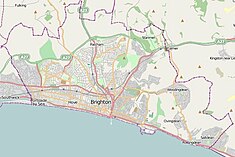Bristol Road Methodist Church
| Bristol Road Methodist Church | |
|---|---|

The church from the southeast
|
|
| Location | Bristol Road/Montague Place, Brighton, BN2 1JE, United Kingdom |
| Coordinates | 50°49′11″N 0°07′28″W / 50.8196°N 0.1245°WCoordinates: 50°49′11″N 0°07′28″W / 50.8196°N 0.1245°W |
| Founded | 1872 |
| Built | 1873 |
| Built for | Reverend J. Martin |
| Architect | Thomas Lainson |
| Architectural style(s) | Romanesque Revival |
|
Listed Building – Grade II
|
|
| Official name: Methodist Church and attached railings | |
| Designated | 26 August 1999 |
| Reference no. | 480447 |
|
Location of Bristol Road within Brighton and Hove
|
|
Bristol Road Methodist Church is a former Methodist place of worship in the Kemptown area of Brighton, part of the English city of Brighton and Hove. Built in 1873 to an Italian Romanesque Revival design, it served this part of eastern Brighton for more than a century until its closure in 1989, after which it became a recording studio. It is owned by Brighton College, an independent school based nearby. The building has been listed at Grade II in view of its architectural importance.
Brighton's first Methodist church opened in 1808 in Dorset Gardens off St James's Street, a recently developed road east of the Old Steine and the Royal Pavilion. By the 1870s, housing had spread much further east, and the area between Thomas Read Kemp's high-class Kemp Town estate and the earlier development around St James's Street had been filled in with high-density housing. The area became known as Kemptown [sic]. In 1872, Reverend J. Martin, a Methodist minister, proposed the construction of a new church to serve this area. Architect Thomas Lainson, who also designed several buildings (including a Congregational church) in Hove and the Middle Street Synagogue in Brighton, was commissioned to draw up a design. He submitted this on 1 March 1872. A builder named John Fielder was responsible for construction, which continued through 1873. A stone tablet (now partly illegible) at the base of the tower, dated 7 October 1873, names Lainson, Fielder and Reverend Martin, and bears the inscription hitherto hath the Lord helped us.
The church was part of the Wesleyan Methodist tradition, and during the early 20th century became part of a circuit of six local Wesleyan churches; the others were the nearby Dorset Gardens Methodist Church (also in Kemptown), Hove Methodist Church, and others in Hurstpierpoint, Portslade and Southwick.
...
Wikipedia

